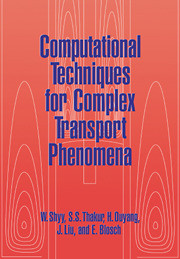Book contents
- Frontmatter
- Contents
- Preface
- 1 Introduction
- 2 Numerical Scheme for Treating Convection and Pressure
- 3 Computational Acceleration with Parallel Computing and Multigrid Method
- 4 Multiblock Methods
- 5 Two-Equation Turbulence Models with Nonequilibrium, Rotation, and Compressibility Effects
- 6 Volume-Averaged Macroscopic Transport Equations
- 7 Practical Applications
- References
- Index
4 - Multiblock Methods
Published online by Cambridge University Press: 30 March 2010
- Frontmatter
- Contents
- Preface
- 1 Introduction
- 2 Numerical Scheme for Treating Convection and Pressure
- 3 Computational Acceleration with Parallel Computing and Multigrid Method
- 4 Multiblock Methods
- 5 Two-Equation Turbulence Models with Nonequilibrium, Rotation, and Compressibility Effects
- 6 Volume-Averaged Macroscopic Transport Equations
- 7 Practical Applications
- References
- Index
Summary
Introduction
There are many physical problems that exhibit multiple length and time scales in the form of, for example, high velocity and temperature gradients, recirculating zones, and phase change fronts, as well as geometric complexities due to the irregular shapes of the flow domain. To handle these characteristics, a multiblock grid method is a very useful technique, allowing different numbers and densities of grid points to be distributed in different regions without forcing the grid lines to be continuous in the entire domain. As reviewed in Chapter 1, there are alternative techniques proposed in the literature to allow gridding flexibility, including structured and unstructured meshes. In the present text, we will concentrate on the structured, multiblock method. The multiblock structured grid is a useful approach because (i) it can reduce the topological complexity of a single structured grid system by employing several grid blocks, permitting each individual grid block to be generated independently so that both geometry and resolution in the boundary region can be treated more satisfactorily; (ii) grid lines need not be continuous across grid interfaces, and local grid refinement and adaptive redistribution can be conducted more easily to accommodate different physical length scales present in different regions; (iii) the multiblock method also provides a natural route for parallel computations.
A detailed account will be given here to address the important issues involved in multiblock methods.
Information
- Type
- Chapter
- Information
- Computational Techniques for Complex Transport Phenomena , pp. 122 - 162Publisher: Cambridge University PressPrint publication year: 1997
